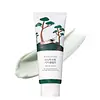What's inside
What's inside
 Key Ingredients
Key Ingredients

 Benefits
Benefits

 Concerns
Concerns

 Ingredients Side-by-side
Ingredients Side-by-side

Water
Skin ConditioningGlycerin
HumectantHydrogenated Palm Acid
Potassium Hydroxide
BufferingPotassium Cocoyl Glycinate
Camellia Sinensis Leaf Extract
AntimicrobialCladosiphon Okamuranus Extract
Skin ConditioningSalix Alba Bark Extract
AstringentCoffea Arabica Seed Extract
MaskingCitrus Aurantium Bergamia Leaf Extract
AstringentSalicylic Acid
MaskingCentella Asiatica Leaf Extract
Skin ConditioningPinus Densiflora Leaf Extract
AntimicrobialCentella Asiatica Extract
CleansingHyaluronic Acid
HumectantHydrolyzed Hyaluronic Acid
HumectantSodium Hyaluronate
HumectantButylene Glycol
HumectantEthylhexylglycerin
Skin ConditioningGardenia Florida Fruit Extract
Skin ConditioningGlycoproteins
Skin ConditioningCapryloyl Salicylic Acid
ExfoliatingAsiatic Acid
Skin ConditioningAsiaticoside
AntioxidantMadecassic Acid
Skin ConditioningMadecassoside
AntioxidantGlyceryl Stearate
EmollientDextrin
AbsorbentDecyl Glucoside
CleansingAcrylates/C10-30 Alkyl Acrylate Crosspolymer
Emulsion Stabilising1,2-Hexanediol
Skin ConditioningSodium Phytate
Water, Glycerin, Hydrogenated Palm Acid, Potassium Hydroxide, Potassium Cocoyl Glycinate, Camellia Sinensis Leaf Extract, Cladosiphon Okamuranus Extract, Salix Alba Bark Extract, Coffea Arabica Seed Extract, Citrus Aurantium Bergamia Leaf Extract, Salicylic Acid, Centella Asiatica Leaf Extract, Pinus Densiflora Leaf Extract, Centella Asiatica Extract, Hyaluronic Acid, Hydrolyzed Hyaluronic Acid, Sodium Hyaluronate, Butylene Glycol, Ethylhexylglycerin, Gardenia Florida Fruit Extract, Glycoproteins, Capryloyl Salicylic Acid, Asiatic Acid, Asiaticoside, Madecassic Acid, Madecassoside, Glyceryl Stearate, Dextrin, Decyl Glucoside, Acrylates/C10-30 Alkyl Acrylate Crosspolymer, 1,2-Hexanediol, Sodium Phytate
Water
Skin ConditioningIsohexadecane
EmollientEthylhexyl Methoxycinnamate
UV AbsorberButylene Glycol
HumectantStearic Acid
CleansingC12-15 Alkyl Benzoate
AntimicrobialGlyceryl Stearate
EmollientCetearyl Alcohol
EmollientNiacinamide
SmoothingAvena Sativa Kernel Extract
AbrasiveOryza Sativa Bran Extract
Skin ConditioningInositol
HumectantGlycerin
HumectantButyl Methoxydibenzoylmethane
UV AbsorberTitanium Dioxide
Cosmetic ColorantZinc Oxide
Cosmetic ColorantDimethicone
EmollientPEG-100 Stearate
Polyacrylamide
C13-14 Isoparaffin
EmollientC9-11 Pareth-6
EmulsifyingAllantoin
Skin ConditioningParfum
MaskingDMDM Hydantoin
PreservativeSodium Lactate
BufferingTetrasodium EDTA
Water, Isohexadecane, Ethylhexyl Methoxycinnamate, Butylene Glycol, Stearic Acid, C12-15 Alkyl Benzoate, Glyceryl Stearate, Cetearyl Alcohol, Niacinamide, Avena Sativa Kernel Extract, Oryza Sativa Bran Extract, Inositol, Glycerin, Butyl Methoxydibenzoylmethane, Titanium Dioxide, Zinc Oxide, Dimethicone, PEG-100 Stearate, Polyacrylamide, C13-14 Isoparaffin, C9-11 Pareth-6, Allantoin, Parfum, DMDM Hydantoin, Sodium Lactate, Tetrasodium EDTA
 Reviews
Reviews

Ingredients Explained
These ingredients are found in both products.
Ingredients higher up in an ingredient list are typically present in a larger amount.
Butylene Glycol (or BG) is used within cosmetic products for a few different reasons:
Overall, Butylene Glycol is a safe and well-rounded ingredient that works well with other ingredients.
Though this ingredient works well with most skin types, some people with sensitive skin may experience a reaction such as allergic rashes, closed comedones, or itchiness.
Learn more about Butylene GlycolGlycerin is already naturally found in your skin. It helps moisturize and protect your skin.
A study from 2016 found glycerin to be more effective as a humectant than AHAs and hyaluronic acid.
As a humectant, it helps the skin stay hydrated by pulling moisture to your skin. The low molecular weight of glycerin allows it to pull moisture into the deeper layers of your skin.
Hydrated skin improves your skin barrier; Your skin barrier helps protect against irritants and bacteria.
Glycerin has also been found to have antimicrobial and antiviral properties. Due to these properties, glycerin is often used in wound and burn treatments.
In cosmetics, glycerin is usually derived from plants such as soybean or palm. However, it can also be sourced from animals, such as tallow or animal fat.
This ingredient is organic, colorless, odorless, and non-toxic.
Glycerin is the name for this ingredient in American English. British English uses Glycerol/Glycerine.
Learn more about GlycerinGlyceryl Stearate is a mix of glycerin and stearic acid.
It is used to stabilize the mixing of water and oil ingredients. By preventing these ingredients from separating, it can help elongate shelf life. It can also help thicken the product's texture.
As an emollient, it helps soften skin and supports barrier-replenishing ingredients.
In cosmetics, Glyceryl Stearate is often made from vegetable oils or synthetically produced.
This ingredient may not be fungal-acne safe
Fun fact: The human body also creates Glyceryl Stearate naturally.
Learn more about Glyceryl StearateWater. It's the most common cosmetic ingredient of all. You'll usually see it at the top of ingredient lists, meaning that it makes up the largest part of the product.
So why is it so popular? Water most often acts as a solvent - this means that it helps dissolve other ingredients into the formulation.
You'll also recognize water as that liquid we all need to stay alive. If you see this, drink a glass of water. Stay hydrated!
Learn more about Water